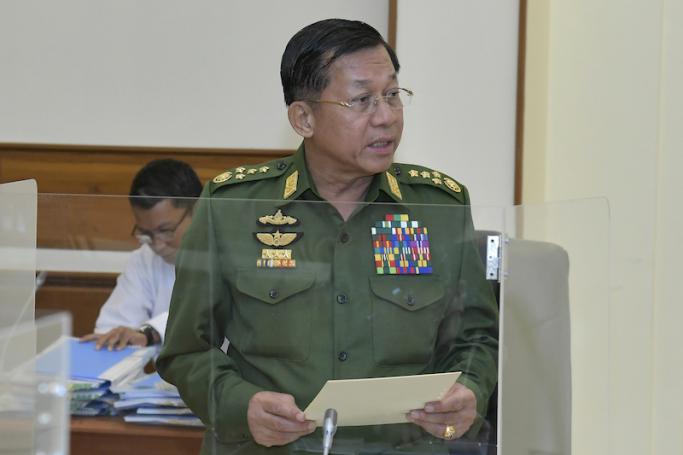Myanmar junta leader Min Aung Hlaing appears to be in a quandary. Over two years after his ill-fated military coup, the general is getting more and more desperate, resorting to increased “shock and awe” aircraft attacks and a shuffling of generals on his military chessboard, as he attempts at the same time to lay a democratic façade over his regime.
30 March saw the Senior General remove some of the military commanders and top officers from their military positions while promoting others, according to local news outlets and sources close to the military. It has been reported that the junta removed Lieutenant General Khin Hlaing from his position as the head of the Bureau of Special Operations 4, responsible for overseeing Karen and Mon states and Tanintharyi Region, following substantial losses in fighting with the Karen National Union (KNU).
Major General Nyunt Win Swe, Commander of the Yangon Region Command, was promoted to the rank of Lieutenant General and has replaced Lieutenant General Khin Hlaing’s position.
Behind the smokescreen of preparations for a democratic election, Min Aung Hlaing’s junta looks set to step up attacks on resistance strongholds in this hot season – essentially a two-month window before the monsoon rains bog down the potential for effective military offensives.
The junta, in a public communique late last year, admitted that they only control 72 out of Myanmar’s 330 townships. In a meeting in February of this year, Min Aung Hlaing reportedly claimed that 198 townships were peaceful, but that the military faced trouble in over 120 townships. In addition, what is clear at this stage is the junta maintains control over the key cities of Naypyitaw, Yangon and Mandalay, although the cities have seen incidents of bombings and assassinations by People’s Defence Forces (PDF).
Battlefield losses are now weighing on the general as he scrambles to try to keep the upper hand. The Myanmar junta is facing the armed wing of the National Unity Government (NUG) and its Spring Revolution, a plethora of PDFs and Ethnic Revolutionary Organizations (EROs).
Min Aung Hlaing must recognize he misjudged the Myanmar people, particularly the young generation from all communities of the country. Analysts say they suspect that when the Senior General ordered his forces to take over the country on 1 February 2021, he expected protests but
that the country would return to the status quo, a disgruntled public accepting that they were once again under military rule – as happened in the wake of the 1988 and 1990s democracy uprisings.
Yet the fighters of the Spring Revolution have surprised many inside and outside Myanmar with their do-or-die resistance.
Min Aung Hlaing is facing military setbacks and is moving around his players on the chessboard, desperately trying to crack down on resistance ahead of what he claims will be a national poll, a date for which has not been set. At the same time, he and his regime are leaning heavily on the support he receives from China and Russia, in terms of diplomacy, trade deals, or the fuel, fighter jets and attack helicopters that allow him to kill his people.
Desperate leaders take desperate measures. What is clear is the next two to three months will see stepped up aerial and ground offensives - yet more brutality as the military pursues a “scorched earth” policy burning villages and torturing and killing civilians.
Min Aung Hlaing ought to hang his head in shame. Not since the Killing Fields of Pol Pot’s Cambodia has a South East Asian country leader demonstrated such cruelty towards his own people.












